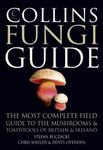Field / Identification Guide Identification Key
By: David Streeter(Author), Christina Hart-Davies(Illustrator), Audrey Hardcastle(Illustrator), Felicity Cole(Illustrator), Lizzie Harper(Illustrator)
704 pages, colour illustrations, b/w line drawings
Following on from its successful launch in 2009, Collins Wild Flower Guide – the ultimate reference book for wild flower enthusiasts – now enters its second edition
![Collins Wild Flower Guide Collins Wild Flower Guide]()
Click to have a closer look
About this book
Customer reviews
Biography
Related titles
Recommended titles
About this book
Featuring all flowering plants, including trees and grasses, and ferns, this fully revised and updated field guide to the wild flowers of Britain and northern Europe is the most complete illustrated, single-volume guide ever published.
Leading botanical artists have been specially commissioned to ensure accurate, detailed illustrations. Species are described and illustrated on the same page, with up-to-date authoritative text aiding identification. Plants are arranged by family, with their key features highlighted for quick and easy reference. The text offers a complete account of over 1,900 wild flowers of Britain and Ireland, along with a summary of their European distribution.
Collins Wild Flower Guide is an indispensable guide for all those with an interest in the countryside, whether amateur or expert.
New to the second edition:
Some of the taxonomy (order) has changed significantly since the first edition was published, and these changes have all been incorporated into the second edition. There are no new illustrations as such, but substantial text corrections and updates in addition to the taxonomic changes. The keys have all been improved on and updated (and in some cases rewritten entirely), making the book inherently more accessible.
The author explains in his introduction to the second edition:
"Recent research in molecular systematics using techniques of DNA sequencing has resulted in a revision of the family relationships between some species of plants. Much of this is a consequence of an international collaborative research project, the Angiosperm Phylogeny Group or APG. The APG system has now been incorporated into the most recent edition of Stace’s standard British flora and has been followed in this new edition of the Guide. In some cases, such as the splitting up of the Scrophulariaceae and the Liliaceae into a number of separate families, this has resulted in some unfamiliar changes although in many cases they had already been predicted by traditional taxonomy."
Thus some plant (Latin) names have also changed, and the new edition reflects these changes. Where the names differ from those in the first edition they are added in parentheses following the new name for reference. The book has also been completely reset and redesigned throughout.
Customer Reviews
Biography
David Streeter is Reader in Ecology in the School of Biological and Environmental Sciences at the University of Sussex and a member of the Editorial Board of the prestigious Collins New Naturalist series. He has served on the council of the Botanical Society of the British Isles and as chairman of its Conservation Committee and he is president of the Sussex Wildlife Trust.
Field / Identification Guide Identification Key
By: David Streeter(Author), Christina Hart-Davies(Illustrator), Audrey Hardcastle(Illustrator), Felicity Cole(Illustrator), Lizzie Harper(Illustrator)
704 pages, colour illustrations, b/w line drawings
Following on from its successful launch in 2009, Collins Wild Flower Guide – the ultimate reference book for wild flower enthusiasts – now enters its second edition
"[...] I have found the book straightforward to use and it is a good introduction to identification keys for those who have just started looking more closely at some of the plants they come across when they are out in the countryside. For those looking to gain more experience it may come in useful alongside other floras: it can sometimes be helpful to have more than one reference to enable you to confirm a tentative ID by following a different key or description."
– Ian Woodward, BTO book reviews














































